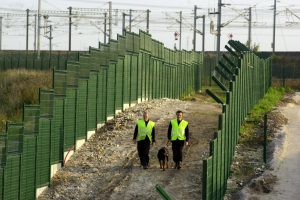Research Question
To what extent are there differences between countries in the Schengen area in the level of crimmigration, the merger between migration control and crime control, and to what extent can these differences be explained by the way in which state and non-state actors in these countries are making use of formal and informal discretion and power structures to guide their response to cross border mobility?
Project Description

This project is driven by growing concerns among academics and NGOs, but also practitioners and citizens, regarding the merger of crime control and immigration control, also known as “crimmigration.” This merger is visible in public and political discourse, in policies and laws, and in certain immigration or law enforcement practices. Immigrants, foreign nationals, ethnic and racial minorities, and poor people have tended to bear the brunt of this transformation. Mobility itself has been subjected to criminalisation, as immigration violations have become subject to criminal penalties rather than administrative sanctions. The concept of borders is frequently discussed in crimmigration literature. Scholars have pointed out that the emerging field of crimmigration control functions as a clear gatekeeper in terms of membership and access. On the one hand, this has resulted in borders being regarded as omnipresent with a wide range of non-traditional social control agents being tasked with sorting out who belongs to a certain society and who does not. On the other hand, physical borders are, once again, being regarded as major tools of exclusion.
Focusing on intra-Schengen border areas
The crimmigration debate is far from settled. Not only is it unclear what the role of discretion (that is, the autonomy enjoyed by some state and non-state actors as to whether or not to apply the law) is in the crimmigration process, but academics also point to the diversity and variation within European societies about the nature, character, and meaning of migration control, especially as it intersects with traditional criminal justice forms. This project aims to contribute to a deeper understanding of the process of crimmigration, the forces and factors that drive it, and the forces and factors that resist it. In doing so, the project focuses on the European Union and, in particular, the Schengen Area and the intra-Schengen borders i.e. the geographical borders between two Schengen countries). Although the Schengen Area is supposed to be a borderless area, growing fears and concerns about mass immigration and various forms of transnational crime such as trafficking and terrorism are increasingly putting the core principles of the European Project, that is free movement, human rights, and solidarity, to the test. In an attempt to reclaim their national sovereignty, several European countries have resorted to far-reaching measures to control the right to enter and remain within the national territory – attempts and measures that have been both applauded and rejected by the people living in these countries.
Focusing on different communities
The project is composed of three different subprojects. Each subproject focuses on a different 'community' playing a role in dealing with, or responding to, intra-Schengen cross-border mobility and the management thereof. One project focuses on the 'community' of local law enforcement officials (border guards etc.) and national policy makers that are responsible for the implementation and execution of the rules and regulations governing migration and cross-border mobilities. The second project focuses on actions taken by citizens and officials in local border municipalities in response to European and national rules and legislation, as well as their practical enforcement. Lastly, the synthesis project will focus, more so than subprojects 1 & 2, on the community of European and national legislators as well as the interactions between the different communities.
Mirroring & Mixed Methods
While conscious of border areas, zones around intra-Schengen borders, and the way in which the different communities mentioned above act within and affect the dynamics within these border areas, the project aims to always mirror the two border areas that are divided by an intra-Schengen border. By looking at, and to a certain extent comparing, two sides of the same intra-Schengen border, the impact of space and locality becomes clear. In studying the different border areas and different communities, the project will combine qualitative research methods (participant observation, interviews, oral histories, and an analysis of media, policy documents, laws and regulations) with quantitative research methods (two multi-sited surveys and an analysis of secondary data).
This combination of research methods and perspectives makes "Getting to the Core of Crimmigration” a truly interdisciplinary research project.
Countries
The countries directly included in this project are: The Netherlands, Germany, Poland, Belgium, Austria and Norway, therefore encompassing a wide variety of Schengen/ Non-Schengen countries, as well as EU/non-EU countries. This, in turn, enables the possibility to look into the different political and legal dynamics of each country.
Advisory Board
An international and interdisciplinary Advisory Board of scholars and practitioners monitors and supports the progress of the project and the collaboration with international and local partners. During the yearly review sessions, and upon request, the board advises the research team on key research and project management questions.


